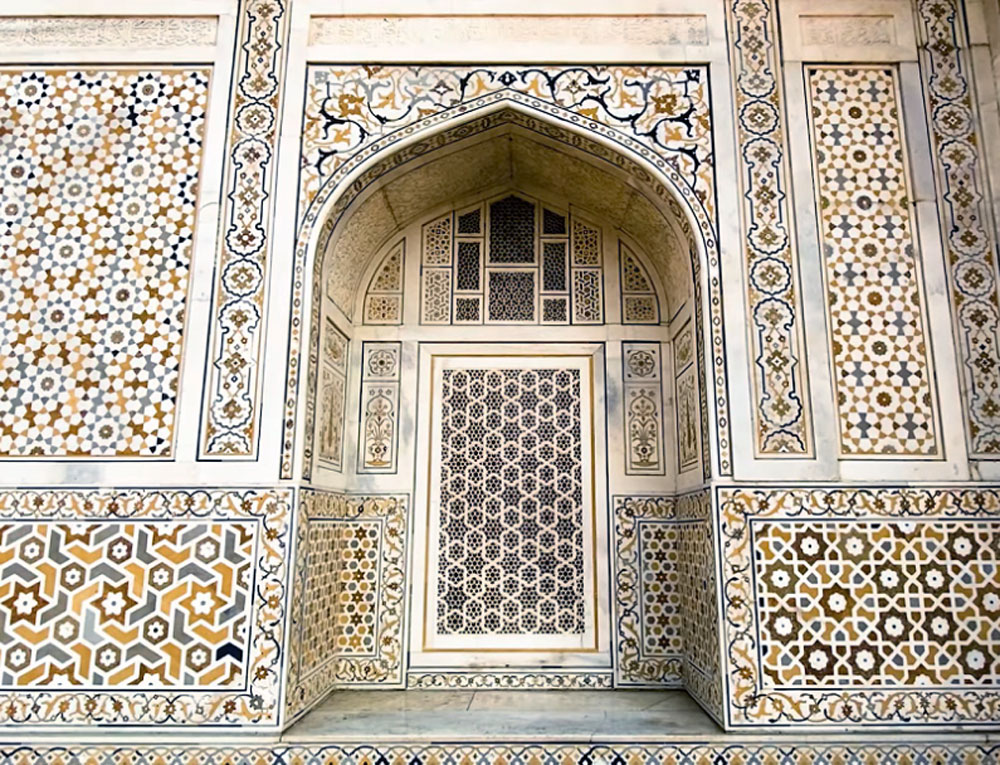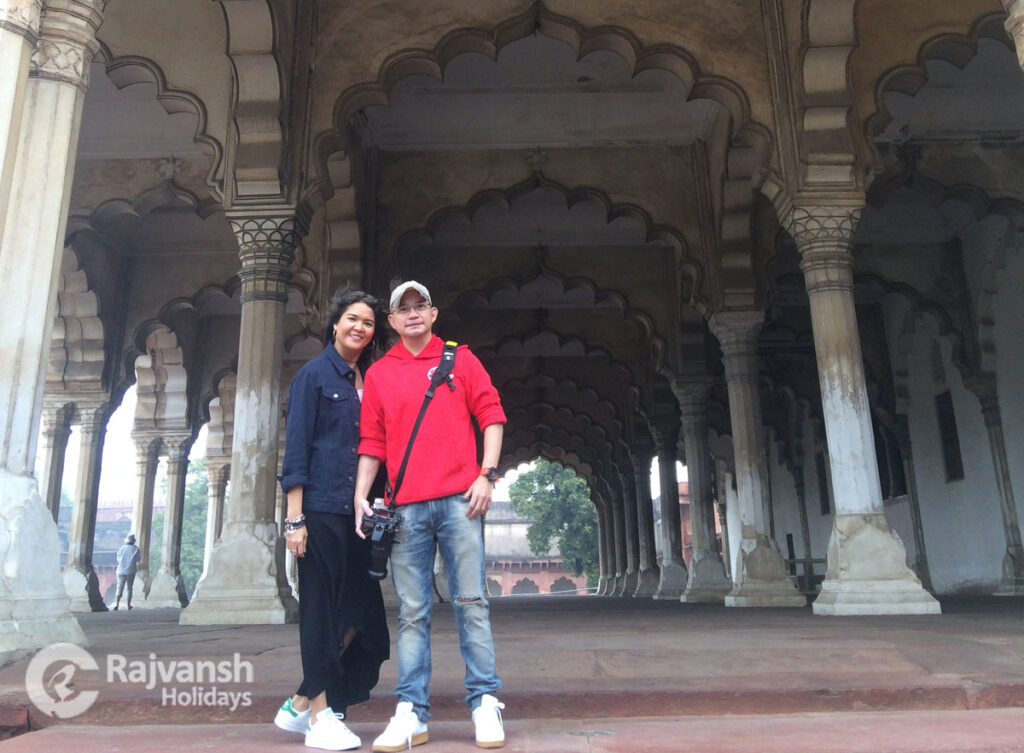Agra, a city full of history and cultural heritage, is famous for architectural wonders like the Taj Mahal and the Agra Fort. However, there is much more to know beyond these iconic sites. The Agra Heritage Walking Tour offers a unique opportunity to discover the city’s lesser-known gems and immerse yourself in its rich cultural tapestry. In this blog, we will embark on a virtual journey through the streets of Agra, highlighting the hidden treasures, vibrant markets, and architectural wonders that make this walking tour an unmissable experience.

To Book Heritage Walk Tour of old City Agra, click the given button below. You will redirect to the Rajvansh Holidays Official website, where you can find more details about the Agra Heritage Walk Tour

A Journey Through Time: Exploring the Heritage City
What is included in Agra Heritage Walking Tour?
- Pick-up and drop-off from Agra Railway Station
- Transportation services by a Toyota Innova vehicle.
- Tour Guide Service for a maximum of 8–10 people
- A detailed explanation of the monuments by a government-approved, licensed guide
- Mineral Water during sight-seeing.
- An experienced English-speaking Tour Guide to accompany your visit (Approved by Ministry of Tourism, Government of India).
- Toll Tax, Parking, Driver allowance, etc.
Setting out on a journey through the overly complex paths of the Ancient City in Agra could be a tactile journey where history, culture, and the dynamic beat of daily life meet. The contract back roads, lined with age-old structures, whisper stories of bygone periods, welcoming brave pioneers to unwind the city’s wealthy tapestry.
Wandering through the Ancient City, one experiences building jewels that stand as quiet witnesses to centuries of social advancement. From resplendent havelis decorated with perplexing carvings to centuries-old mosques that resound with the supplications of eras, each corner exudes the pith of Agra’s chronicled narrative. The hustle and flurry of the nearby markets within the ancient city give a distinctive grandstand to Agra’s modern, dynamic quality. Sellers hawk their products, and the discussion is thick with the smells of road nourishment, creating an environment that tantalizes the faculties. The Ancient City’s markets are a treasure trove of conventional painstaking work, materials, and culinary delights, advertising a glimpse into the true beat of Agra.
As sunshine blurs, the Ancient City changes into a canvas enlightened by the warm gleam of legacy structures. The evening call to supplication resounds through the contract paths, including a otherworldly song to the vibe. Investigating the Ancient City at night reveals a distinctive charm, with antiquated structures casting charming shadows and the far off outline of the iconic Taj Mahal making a mesmerizing backdrop.
In each step through the Ancient City’s meandering ways, one can feel the discernible association between the past and the show. Agra’s Ancient City isn’t only a physical space but a living encapsulation of the city’s versatility, typifying the collective recollections of its occupants and the persevering soul that has withstood the test of time. In essence, investigating the Ancient City of Agra isn’t just a journey through authentic paths; it’s an immersive involvement, a dialogue with the soul of a city that has smoothly grasped the passage of time while holding the realness of its social character.
Exploring the Wonders of Mughal Architecture

Embarking on a journey to explore the Mughal architecture of Agra is like stepping into a captivating chapter of history, where each landmark tells a story of royal grandeur and artistic brilliance. Agra, a living testament to Mughal heritage, unveils its architectural treasures at every turn, inviting visitors to delve into a world where the past seamlessly merges with the present. At the heart of this architectural wonder stands the renowned Taj Mahal, a timeless symbol of eternal love. It was commissioned by Emperor Shah Jahan in memory of his beloved wife, Mumtaz Mahal. The Taj Mahal’s exquisite ivory-white marble facade, intricate floral designs, and symmetrical beauty create a masterpiece that transcends time. As visitors stand before its majestic splendor, they are transported to an era where love and creativity converged to create an iconic symbol of Mughal architecture.
Adjacent to the Taj Mahal lies the imposing Agra Fort, a UNESCO World Heritage Site that exudes military prowess and regal elegance. The Agra Fort was constructed by Emperor Akbar; this red sandstone fortress showcases a harmonious blend of Persian, Turkish, and Indian architectural styles. Its towering walls, opulent palaces, and the magnificent Diwan-i-Khas, adorned with white marble and intricate carvings, exemplify the Mughal emperors’ mastery in combining functionality with artistic finesse.
Fatehpur Sikri is an abandoned city that echoes the grandeur of Mughal urban planning. Fatehpur Sikri’s red sandstone structures, including the Buland Darwaza and the Jama Masjid, showcase the architectural prowess of the Mughal era. The Panch Mahal, with its five distinct stories, and the intricately designed Salim Chishti’s Tomb stand as timeless examples of the era’s aesthetic brilliance. As one meanders through the ancient bazaars and bustling streets of Agra, the city’s lesser-known architectural gems come to light. The Itmad-ud-Daulah’s Tomb, often referred to as the “Baby Taj,” boasts delicate marble filigree work and intricate lattice screens, offering a glimpse into the opulence that defines Mughal architecture.
In essence, discovering the Mughal architecture of Agra is not merely a visual spectacle; it is an immersive experience into the lavish legacy of a bygone era. Each structure, from the majestic Taj Mahal to the hidden gems within the city, invites visitors to unravel the intricate details of Mughal craftsmanship and the cultural nuances embedded in every curve and arch. Agra, with its architectural splendors, stands as a living museum, welcoming all to witness the enduring beauty of Mughal heritage.
Agra’s cultural heritage unveiled

Agra’s cultural heritage is a collection of diverse influences, woven together by the Mughal emperors who ruled India for more than three centuries. The city’s architecture, art, music and cuisine reflect this rich heritage, giving visitors a glimpse of a bygone era.
“Incredible Architecture of Agra”
Some of the world’s most famous architectural wonders, such as the Taj Mahal, Agra Fort, and the Tomb of Itmad-ud-Daula, can be found in Agra. These structures, which exhibit exquisite craftsmanship, amazing symmetry, and ethereal beauty, are masterpieces of Mughal architecture. One of the Seven Wonders of the World and a UNESCO World Heritage Site, the Taj Mahal is a timeless representation of love and devotion. The Taj Mahal, a stunning work of ivory and white marble built by Emperor Shah Jahan in the 17th century as a mausoleum for his beloved wife, Mumtaz Mahal, is a testament to the enduring influence of the Mughal Empire. The “Baby Taj,” or the Tomb of Imam-ud-Daula, is an equally wonderful but lesser-known architectural wonder. This magnificent marble mausoleum competes in grandeur with its finely detailed inlay patterns, elaborate lattice work, and delicate carvings.
Unveiling of cultural heritage
Agra’s cultural heritage is much more than its beautiful buildings. On this walking tour you’ll learn about the city’s rich artistic traditions, such as marble inlay work, carpet weaving and embroidery. You’ll visit workshops and meet local artisans, who will share their insights into their craft and explain how they are preserving traditional arts. The tour will also include a visit to Shero’s Hangout, a café run by acid attack survivors. This café is a symbol of resilience and empowerment of women in Agra.
Agra’s Culinary Canvas: A Fusion of Flavors and Cultures
Agra, past its building splendors, calls travelers on a culinary journey that tantalizes the taste buds with an orchestra of flavors. The city’s culinary delights, profoundly established in Mughlai conventions, offer a feast for the faculties, welcoming both local people and guests to savor the wealthy embroidered artwork of Agra’s gastronomic heritage.
1. Mughlai Food: An Illustrious Affair
Agra’s culinary scene is synonymous with the wanton flavors of Mughlai food, a illustrious bequest passed down from the Mughal sovereigns. Enjoy in fragrant biryanis, juicy kebabs, and wealthy curries that carry the pith of majestic kitchens. The rich liberality of butter chicken, the tantalizing flavors of kebabs, and the sensitive layers of biryani grandstand the culinary extravagance that characterizes Agra’s feasting experience.
2. Road Nourishment Extravaganza
Agra’s limit paths come lively with a dynamic road nourishment culture, where nearby sellers dish out scrumptious treats that are a genuine reflection of the city’s differing culinary impacts. From the sweet and syrupy jalebis to the savory delights of chaat and samosas, each road corner offers a modern culinary enterprise. The smell of sizzling kebabs and the savoriness of pani puri make a tactile ensemble that captivates both local people and nourishment enthusiasts.
3. Petha: Agra’s Sweet Emblem
No culinary travel in Agra is total without savoring the famous sweet treat – Petha. This translucent, candied fiery debris gourd is synonymous with the city and comes in a assortment of flavors, counting the classic plain, saffron-infused, and paan (betel leaf) flavored. Agra’s Petha has risen above its nearby beginnings to gotten to be a broadly eminent delicacy, drawing guests from distant and wide.
4. Dal Moth and Gajak: Crunchy Delights
For those with a propensity for crunchy delights, Agra offers Dalmoth and Gajak. Dalmoth, a savory blend of lentils, nuts, and flavors, gives a fulfilling crunch, whereas Gajak, a sweet made of sesame seeds and jaggery, includes a delightful sweetness to the culinary collection. These treats, frequently delighted in amid celebrations and uncommon events, encapsulate the different flavors woven into Agra’s culinary fabric.
5. Agra’s Special Lassi Experience
Quench your thirst with Agra’s one of a kind take on the conventional lassi. The city is eminent for its reviving and foamy Bedai ki Lassi, a yogurt-based drink that combines sweetness and a indicate of zest. Served in earthen glasses, this neighborhood claim to fame gives a cooling break, particularly amid the warm Agra days.
6. Culinary Differing qualities in Ancient Bazaars
Exploring the ancient bazaars of Agra isn’t fair a shopping undertaking; it’s a culinary experience. The bustling markets offer a heap of neighborhood snacks and specialties, from fiery kachoris to luscious chaat. In the midst of the dynamic embroidered artwork of textures and crafted works, the smell of road nourishment calls, making an powerful allurement for culinary exploration.
In quintessence, the culinary delights of Agra go past being a simple gustatory encounter; they are a celebration of the city’s social legacy and a travel through the assorted flavors that have formed its character. Agra’s food, like its famous landmarks, welcomes everybody to share in a tangible travel that clears out a enduring engrave on the sense of taste and the heart.
Interact with local people
A key feature of the Agra Heritage Walking Tour is the chance to engage with the local community. Participants will have the opportunity to meet Agra residents with a long-standing connection to the city, hear their narratives, anecdotes and folklore intricately woven into the fabric of Agra. The purpose of these visits is to provide a more in-depth information about the city’s historical nuances, cultural richness and daily life. Additionally, visitors will be able to participate in cultural programs such as traditional music and dance performances, which will add to the authenticity of the overall experience.
With this Agra Heritage Walking Tour, you can easily modify the schedule to meet your specific needs. You can include visits to local villages, temples, culinary sites, ancient stores of Agra, home tours, and much more. This Agra Same Day Heritage Walking Tour offers visitors the opportunity to immerse themselves in the city’s rich history, architecture, and culture while also benefiting from the benefits of walking the streets and neighbourhoods. It is a means of learning more about the history of Agra and its place in the historical narrative of India.
To book a Heritage Walk Tour of Old City Agra, click the given button below. You will be directed to the Rajvansh Holidays Official website, where you can find more details about the Agra Heritage Walk Tour

Contact Rajvansh Holidays for travel information, tour bookings, tickets, transportation, or hotel bookings in Agra and for other destinations in India. Just call or WhatsApp us at +91 98370 44720. You can also visit our official website: www.tajmahaltourguide.com

